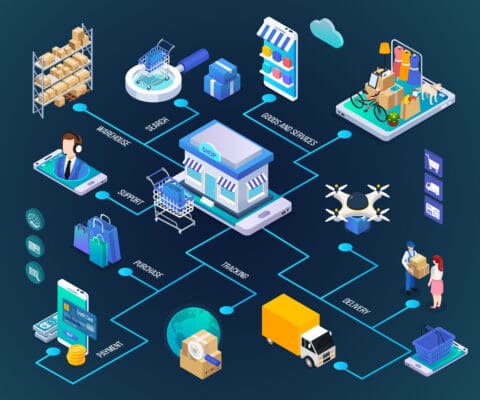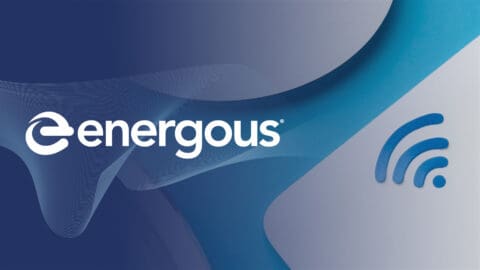Introduction
Retail operations rely on the supply chain to manage the production and delivery of goods to customers, from sourcing raw materials and manufacturing to warehousing and distribution. A well-functioning supply chain is critical for a retailer’s success, not just in terms of inventory management and profitability, but also in ensuring that consumers receive fresh, high-quality products.
Traditional supply chain management technologies such as optical and RFID scanners often fall short in addressing critical supply chain challenges, as they require manual operation which means they are susceptible to human error. They also provide limited data visibility. These outdated solutions can lead to miscommunication, data silos, and slow response times, resulting in delays, increased costs, and lost sales.
To optimize supply chain processes, retailers need more granular levels of visibility into their supply chains. As a result, they are increasingly adopting innovative solutions like the Internet of Things (IoT) to increase visibility, control, and intelligent business automation.
Understanding IoT in Retail Supply Chain Management
The Internet of Things (IoT) refers to a network of interconnected devices that collect and exchange data in real time. In retail supply chains, IoT-enabled devices can range from sensors, electronic shelf labels, and asset trackers, to air quality monitors, motion detectors, and more. These devices collect critical data on inventory levels, product conditions, and logistics, and transmit it to cloud networks, allowing retailers to make informed decisions and streamline operations.
Ambient IoT is a new class of connected devices that use energy from the environment to power themselves and communicate wirelessly. They operate without batteries, harnessing ambient energy sources like radio frequencies or solar power, making them useful for retail applications, where they enable constant monitoring and data collection of inventory –without requiring regular maintenance.
Demand Forecasting: Accuracy and Optimization
Accurately predicting customer demand is a key challenge for retailers, as it is crucial for maintaining optimal inventory levels and avoiding stockouts or overstock situations. Traditional methods typically rely on historical sales data and manual processes, which can be slow, error prone, and are unable to incorporate the impact of demand drivers and future events such as weather or holidays.
According to a study by McKinsey, companies with advanced demand forecasting processes can reduce inventory levels by up to 20 percent while improving supply chain costs by up to 10 percent. IoT-enabled devices allow retailers to accurately predict demand, ensuring that the right products are available at the right time. This technology supports a more diverse product selection, reducing the likelihood of stockouts and ensuring consumers have access to what they want when they want it.
Ambient IoT-enabled sensors can harvest radio frequency (RF) energy waves – without the need for batteries – providing businesses with a low-cost solution that offers real-time access to critical information. When combined with advanced data analytics solutions, retailers are able to make quick, proactive adjustments to forecasts, reducing the risk of overstock or stockouts and improving supply chain efficiency.
Inventory Management: Efficient and Cost-Effective
The goal of any supply chain manager is to ensure they get the right products to the right place at the right time, at the lowest possible cost. However, this can be a challenge as it depends on how well the retailer sources, produces, transports, and delivers its products.
Effective inventory management ensures that products are available when and where customers need them. Common issues include overstocking, understocking, and misaligned stock levels across locations, which can lead to financial setbacks like wasted resources, missed sales opportunities, and increased costs. Preventing these setbacks can lead to massive savings that can be passed on to the customer.
A report by Total Retail highlights that poor inventory management can lead to financial losses amounting to $300 billion annually for U.S. retailers. IoT technology enables real-time inventory tracking, providing precise data to optimize stock levels and reduce carrying costs.
With Ambient IoT solutions, retailers can easily and effectively create a virtual representation of their supply chain that accurately reflects the real thing. This allows them to monitor all aspects of their supply chain, from tracking inventory levels and asset locations to creating heatmaps of customer activities and interactions with products. These ‘digital twins’ can be used to simulate how a product or process will perform, and then be updated with real-time data to help make decisions to optimize the supply chain.
Cold Chain Management: Quality and Compliance
Cold chain management involves maintaining the integrity of temperature-sensitive products throughout the supply chain, from perishable food products to critical medications. Temperature fluctuations and inadequate monitoring can result in spoilage and compliance issues. The World Health Organization (WHO) reports that up to 50 percent of vaccines are wasted globally every year due to temperature control and logistics issues.
Ambient IoT-enabled sensors can provide ‘always on’ temperature and humidity monitoring from the warehouse to the truck to the shelf, ensuring cold chain requirements are met and offering a scalable, flexible solution for real-time visibility into the conditions of temperature-sensitive products. They can transmit data over long distances and through various environments, sending alerts if temperatures deviate from the acceptable range to allow immediate corrective action and prevent spoilage. By preventing spoilage and reducing waste, retailers can maintain high product quality while potentially passing on savings to consumers. Furthermore, the data collected can be analyzed to identify patterns and potential issues before they become critical, ensuring compliance with regulations and optimal product conditions.
Increasing Regulatory Pressures and the Need for Transparency
As global regulations become stricter, the need for transparent and data-rich supply chains is critical. Regulatory bodies require detailed reporting on product origins, handling, and storage conditions. Retailers must comply to avoid penalties and maintain consumer trust.
IoT-enabled inventory management systems provide necessary transparency by offering real-time data on every aspect of the supply chain. These systems track and record product conditions throughout transportation and storage, helping retailers comply with regulations and optimize operations.
By leveraging Ambient IoT technology, retailers can create a transparent, data-driven supply chain that meets regulatory standards and enhances efficiency and reliability. This approach safeguards businesses from regulatory penalties and builds consumer confidence in the brand’s commitment to quality and compliance.
Wireless Power Networks (WPNs) play a crucial role in Ambient IoT, providing a reliable and continuous power source for all connected devices while also facilitating data transmission. With WPNs, connected devices can operate without batteries, wires, or cables, reducing maintenance and ensuring uninterrupted monitoring.
Transforming the Retail Supply Chain with Wireless Power Networks
Retailers can transform their supply chain with wireless power networks. WPNs, including technologies developed by companies like Energous, deliver over-the-air power to connected devices such as sensors and tags, ensuring they are continuously charged and able to provide critical enterprise data to cloud networks without wires, batteries, or cables. WPNs ensure continuous operation of IoT devices, supporting a highly efficient supply chain. This efficiency translates to better product availability and can help retailers maintain competitive pricing, benefiting both the end consumer and the retailer.
Energous PowerBridge transmitter systems are the backbone of WPNs, allowing connected devices to efficiently communicate valuable data and insights back to the cloud. This capability enables companies to analyze, optimize, and improve every part of their supply chain operations in real-time. Designed for next-generation enterprise IoT applications, Energous wireless power solutions deliver an always-on, over-the-air automated energy flow that optimizes IoT device performance.
WPNs meet the increasing demand for power over distance, crucial for asset tracking and monitoring across multiple zones. This includes supply chain visibility, cold chain monitoring, fleet management, and temperature and humidity monitoring.
Building a Seamless Digital Supply Chain
Retail supply chains are complex and face numerous challenges that can impact their efficiency and effectiveness. By leveraging advanced technologies such as IoT and Wireless Power Networks, retailers can overcome these challenges and build a seamless digital supply chain. Energous offers over-the-air charging WPN solutions that address key supply chain issues, helping retailers stay competitive in a rapidly evolving market.
Schedule a demo with Energous today to seamlessly digitize your supply chain operations.

Wireless Power: Revolutionizing The Manufacturing Sector
The company is growing its wireless energy solution to power BLE tags with new certification for use in Japan, and has teamed up with InnoTractor and Thinaer.

Unlocking the Future with Energous’ Radio Frequency Wireless Charging
Energous advances RF wireless charging, offering versatile and cost-effective power solutions that redefine efficiency and convenience in various sectors from healthcare to IoT.

About Energous
Pushing the boundaries of power, Energous leads the way in wireless power solutions. With over 200 patents, 30+ PoCs, and regulatory certification in 114 countries, Energous leverages its global expertise to deliver cutting-edge technology for IoT markets. Energous solutions enable efficient over-the-air power transmission as well as data transmission over


